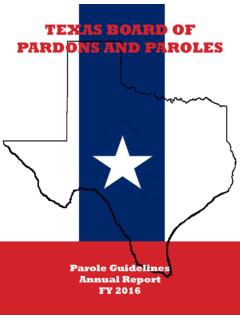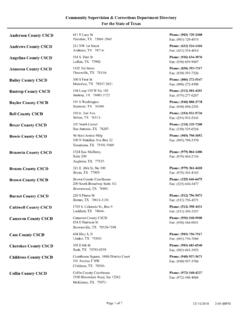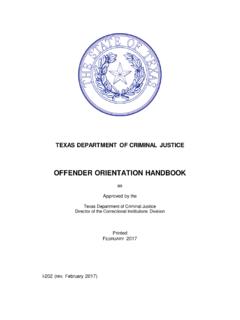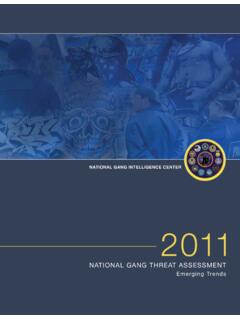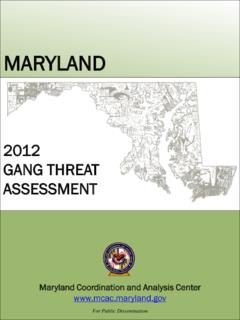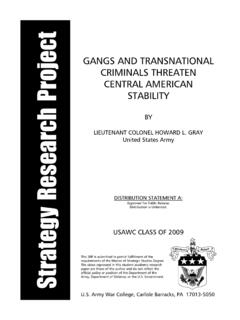Transcription of TEXAS BOARD OF PARDONS AND PAROLES - tdcj.texas.gov
1 TEXAS BOARD OFPARDONS AND PAROLESP arole GuidelinesAnnual ReportFY 2017 Published by:The TEXAS BOARD of PARDONS and PAROLES David Guti rrezChair and Presiding Officer P. O. Box 13401 Capitol Station Austin, TEXAS 78711 January 2018 MISSION AND VISION STATEMENTS ..2 INTRODUCTION ..3 HISTORY OF TEXAS parole GUIDELINES ..5 COMPONENTS OF THE GUIDELINES ..7 Risk assessment Instrument ..7- Static Factors ..7 - Dynamic Factors ..7 Offense Severity Class ..7 THE parole GUIDELINES SCORE ..8 ACTUAL APPROVAL RATES FY 2017.
2 9 Guidelines Level Statewide, Approval Rate by Guidelines Level ..9 Guidelines Level by Regional Office ..10 - 16- Amarillo BOARD Office ..10- Angleton BOARD Office ..11- Austin BOARD Office ..12- Gatesville BOARD Office ..13- Huntsville BOARD Office ..14- Palestine BOARD Office ..15- San Antonio BOARD Office ..16 TABLE OF CONTENTS TEXAS BOARD of PARDONS and Paroles1 TEXAS BOARD of PARDONS and Paroles2 The mission of the TEXAS BOARD of PARDONS and PAROLES is to perform its duties as imposed by Article IV, Section 11, of the TEXAS Constitution and: Determine which prisoners are to be released on parole or discretionary mandatory supervision; Determine conditions of parole and mandatory supervision; Determine revocation of parole and mandatory supervision.
3 And, Recommend the resolution of clemency matters to the TEXAS BOARD of PARDONS and PAROLES , guided by sound application of the discretionary authority vested by the Constitution of the State of TEXAS , shall: Render just determination in regard to parole release and revocations, thereby maximizing the restoration of human potential while restraining the growth of prison and jail populations; Impose reasonable and prudent conditions of release consistent with the goal of structured reintegration of the offender into the community.
4 And, Resolutely administer the clemency process with recommendation to the Governor fully commensurate with public safety and due STATEMENTVISION STATEMENTIn accordance with Section , Government Code, the TEXAS BOARD of PARDONS and PAROLES annually shall submit a report to the Criminal Justice Legislative Oversight Committee, the Lieutenant Governor, the Speaker of the House of Representatives, and the presiding officers of the standing committees in the Senate and House of Representatives primarily responsible for criminal justice regarding the BOARD s application of the parole guidelines adopted under Section information in this report was obtained from the TEXAS Department of Criminal Justice who is responsible for maintaining and providing statistical information relating to parole and mandatory supervision pursuant to Government Code Section (b).
5 BOARD Rule Standard parole Guidelines:(a) The parole panels are vested with complete discretion in making parole decisions to accomplish the mandatory duties found in Chapter 508, Government Code.(b) parole guidelines have been adopted by the BOARD to assist parole panels in the selection of possible candidates for release. parole guidelines are applied as a basis, but not as the exclusive criteria, upon which parole panels base release decisions. (1) The parole guidelines consist of a risk assessment instrument and an offense severity scale.
6 Combined, these components serve as an instrument to guide parole release decisions. (2) The risk assessment instrument includes two sets of components, static and dynamic factors. (A) Static factors include: (i) Age at first admission to a juvenile or adult correctional facility; (ii) History of supervisory release revocations for felony offenses; (iii) Prior incarcerations; (iv) Employment history; and (v) The commitment offense. (B) Dynamic factors include: (i) The offender s current age; (ii) Whether the offender is a confirmed security threat group ( gang ) member; (iii) Education, vocational and certified on-the-job training programs completed during the present incarceration; (iv) Prison disciplinary conduct; and (v) Current prison custody level.
7 (3) Scores from the risk assessment instrument are combined with an offense severity rating for the sentenced offense of record to determine a parole candidate s guidelines level.(c) The adoption and use of the parole guidelines does not imply the creation of any parole release formula, or a right or expectation by an offender to parole based upon the guidelines. The risk assessment instrument and the offense severity scale, while utilized for research and reporting, are not to be construed so as to mandate either a favorable or unfavorable parole decision.
8 The parole guidelines serve as an aid in the parole decision process and the parole decision shall be at the discretion of the BOARD and the voting parole TEXAS BOARD of PARDONS and PAROLES guidelines combine a research-based risk assessment of the offender with a measurement of the severity of the offense. The risk assessment measures the likelihood of an offender to have a successful parole . It uses both an offender s historical (Static) information and current (Dynamic) situation. INTRODUCTIONT exas BOARD of PARDONS and Paroles3 The assessed level of risk combines with the offense severity ranking to create a parole Guidelines Score.
9 The score ranges from one to seven one indicates the poorest probability, and seven the greatest, for success on parole . While the BOARD seeks to maximize the state s ability to restore human potential to society through the granting of parole , its first priority always is public range of Recommended parole Approval Rates utilized by the BOARD in this Annual Report was developed by a consultant to the BOARD in 2001. The range of recommended parole approval rates were established to monitor its compliance for each category or score within the BOARD realizes individual voter and aggregate release decisions may not fall within the Recommended parole Approval range.
10 The following explanations are provided for the variations that exist between the Actual parole Approval Rates for individual parole panel members, regional offices and the state as a whole to the range of Recommended parole Approval Members and parole Commissioners vote cases on a daily basis; therefore, at the time of the parole panel member s vote, the current monthly aggregate total by approval rates are not available to them. Additionally, the parole Guidelines are only one of the tools utilized by the parole panel members when making individual offender discretionary decisions.
